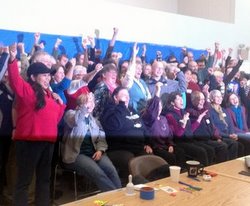What happens when you invite an entire community to present dozens of ideas for improving public health, and to whittle those ideas down to 2 or 3 in a single day? Progress. In other communities this might be a recipe for mayhem, or empty promises. But the Sitka Health Summit has a track record of choosing ideas that lead to action. KCAW’s Emily Forman attended the Health Summit planning meeting last Friday, where Sitkans decided to tackle meth addiction and food security.
Listen to iFriendly audio.
I’ve attended innumerable one-day conferences, and remember very few with tangible results, or with stretching and breathing exercises led by yoga instructors…
Emily: Inhale and exhale.
The exercise break was not the only thing that made the 7th annual Sitka Health Summit unique. This year, the two projects chosen reflect the community’s desire and energy to tackle two issues related to trends afflicting a growing number of families in Sitka.
There were 2 projects selected to receive $1,500 in seed funding, and continued support from the Sitka Health Summit. The Sitka Food Hub – which would serve as a food bank, and an emergency food storage. And Together For Meth-Free Sitka – a task force to address issues related to meth addiction.
In past years, the Sitka Health Summit goals emphasized physical fitness or healthy eating. Chester Miyasato, with the Sitka Tribe of Alaska, was once an honoree for exemplifying previous wellness goals:
Chester: I do 40 miles of biking per week round trip from my home to work and during my lunch hours I walk anywhere from 12-13 miles a week during my lunch hours.
And then there’s the Fish to Schools program – a result of last year’s planning meeting, aimed at serving a healthy locally sourced school lunch.
Doug: boom fish tacos! The amazing thing about this program is they had fish in schools that year.
But this year, the community seems to be looking beyond healthy habits, towards fundamental health needs – that have to do with issues too pervasive to ignore.
For instance, this public plea, by Sitka High School principal Dr. P.J. Ford Slack, likely inspired votes for the Sitka Food Hub:
“I have watched in 4 short year here the increase of students that are coming to school to find something to eat. I have written off over $500k worth of lunch accounts because for the students this is maybe the only meal they get even if its not the most nutritious meal.”
In addition to hunger, meth addiction was highlighted as another threat to public health in Sitka, and the root cause of a wide spectrum of issues. I spoke with Phil Berdick, the co-principal of Pacific High School about a trajectory he’s witnessed in the school over the past 15 years.
“I’ve always had homeless kids, last year we were 50% homeless – half of my kids were homeless.”
Phil attributes homelessness to meth and heroin addiction plaguing many families of students at Pacific High.
“This is a huge thing that’s going on that people are waking up to but in my opinion not fast enough. And I love this organization and what they have done for this community but they are really safe and they are really middle class goals.”
Throughout the day, there were many other ideas proposed – and some were related to the broader goals selected.
“I put sex trafficking intervention,” said Glade Morales.
Morales says that this is a too common occurrence in Sitka’s middle school and high school. She is eager for change.
“Get them back to doing things that kids should worry about doing. Oohh like playing tag on the playground, stuff like that. They shouldn’t be think about when they’re going to get their next bump or their next meal. A lot of the times they’re selling themselves for money for food because they’re poor they don’t have anything.”
Many other ideas were brought up that reflected the diversity of the attendees.
For example Paulette Moreno, the acting president of the Alaska Native Sisterhood, proposed a revitalization of Katlian street, for the sake of honoring Sitka’s heritage.
“Look at people that are from here from time and memorial for tens of thousands of years and learn from the people.”
And for the first time, Sitka High School student leaders participated.
Owen: Hello I’m Owen Fulton I’m the all student body president for Sitka High School.
Debby: If schools did something like this is would be very helpful.
Owen: Yeah, anyone of these ideas we could have student involvement with them like a volunteer network, we could have the high school help out with Katlian revitalization. Our principle would like to see us hold our own mini health summit at the school.
And rounding out the group, there was a show of appreciation from Nancy Yaw:
“Thank you so much for having us and including us vintage folk!”
Around 1 pm, when the top 2 wellness goals were announced, if there was any post-lunch lethargy, it was undetectable.
Doug: [Drum roll sounds] The number 2 top official Sitka Health Summit goal is community food bank.
Crowd: Cheers.
Doug: So the top idea with 129 votes was drug task force to address meth and heroine problem in Sitka.
Crowd: Cheers.
The community had spoken, with resounding energy, ready to tackle the next phase for improving Sitka’s Health.































